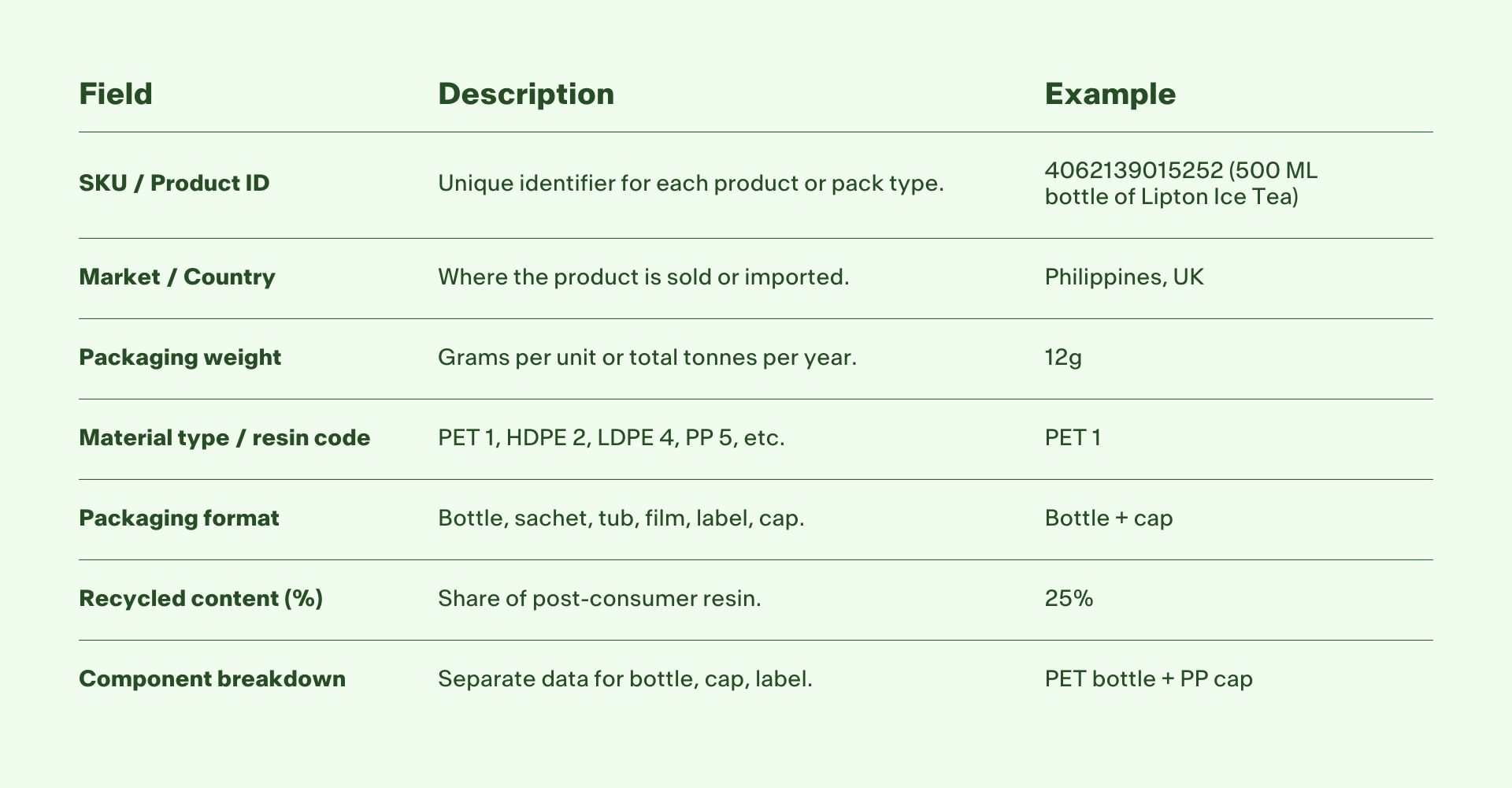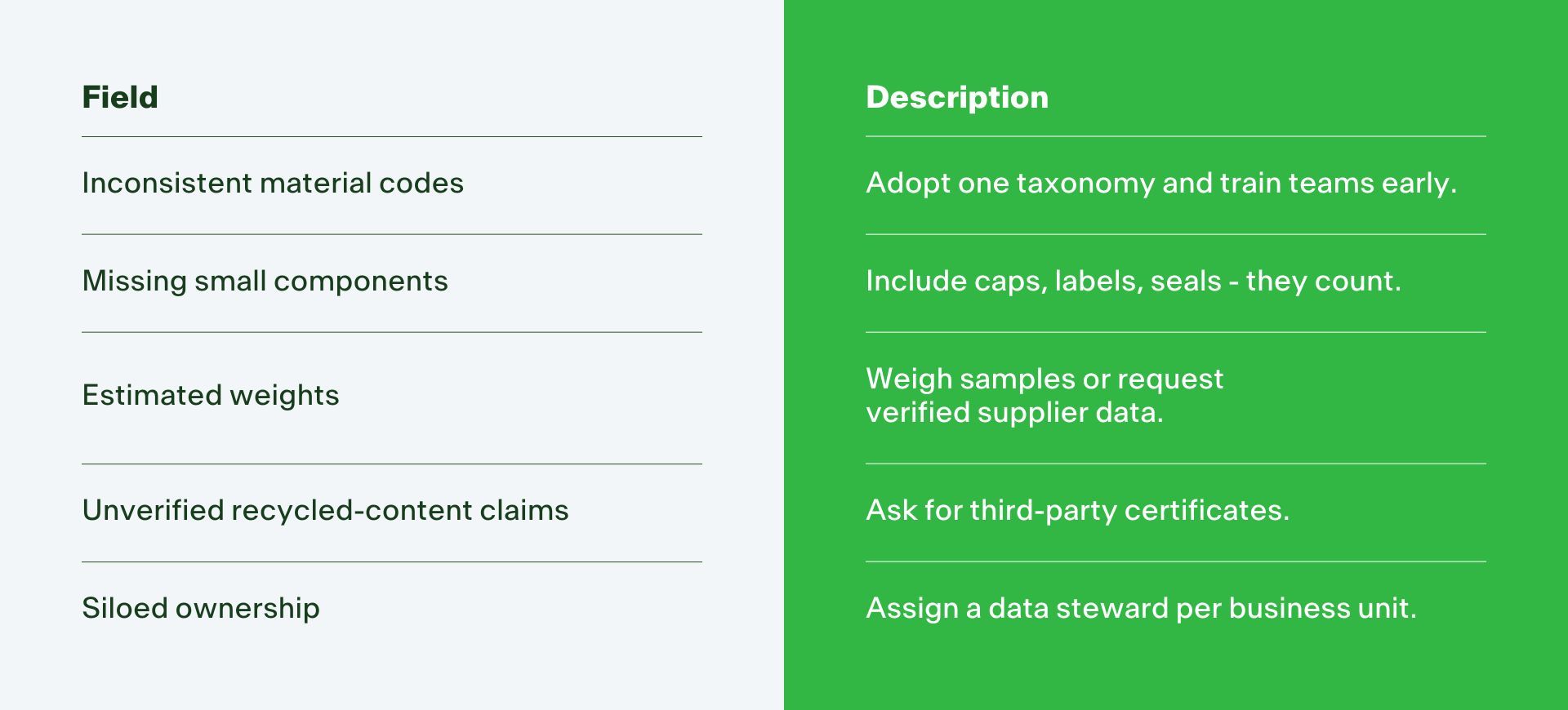EPR Reporting Made Simple: The Core Data Every Producer Needs to Capture

If Part 1 of this series explained what Extended Producer Responsibility (EPR) is, this post answers the next question: how do you actually report your data?
Every EPR law, from California’s SB54 to the EU’s Packaging and Packaging Waste Regulation( PPWR), hinges on one thing: accurate data about the plastic packaging you put into the market.
This guide breaks down what data to collect, how to structure it, and how to keep it audit-ready so you can stay compliant.
1. Why EPR data matters
Your EPR data is more than a spreadsheet - it’s the foundation of your compliance, your cost forecast, and your credibility:
- Data sets your fees. Producer Responsibility Organizations (PROs) calculate contributions based on your reported plastic volumes and recyclability.
- Data shows performance. Governments use aggregated reports to measure national recycling progress, for example under the OECD EPR guidance.
- Data protects your reputation. Reliable data supports ESG disclosures and avoids audit findings or greenwashing claims.
Think of EPR data as the backbone of both compliance and transparency.
2. The minimum data every producer needs
Before you can submit a report, you need a single source of truth about your packaging. Below are the core data fields most authorities require for plastic packaging, based on the UK DEFRA EPR guidance and global best practice from PwC Global EPR 2025.

Optional but useful fields: supplier name, PRO registration number, and fee category or eco-modulation band.
3. Where to find your packaging data
The required data doesn’t live in one place. It typically resides across teams and systems.
Typical internal EPR data sources:
- Packaging design / R&D → technical specs and weights.
- Procurement and/or suppliers → resin types and recycled content certificates.
- ERP or PLM systems → product SKUs and volumes sold.
- Sales or customs reports → confirm which markets products enter.
Start with your top 20 SKUs in one market; validate the information, then scale.
4. Structuring data for easy reporting
Once you’ve located your EPR data, the next challenge is keeping it organised and repeatable.
Good structure = less chaos
- Build a master spreadsheet or database with one row per SKU per market.
- Use consistent material codes (e.g., EU CEN or ISO 1043 standards).
- Add data owner and last-updated date for accountability.
- Link supporting evidence (supplier declarations, lab tests, invoices).
Frequency and cadence
Most EPR systems require quarterly or annual submissions. Where possible, align EPR deadlines with your fiscal or ESG calendar. The UK, for instance, requires large producers to report twice yearly and to keep records for at least seven years (UK Government, DEFRA, 2025). In the U.S., state EPR laws also set fixed reporting windows. For example, producers in Oregon must submit their first report by March 31, 2025, while California producers must report by November 15, 2025 under the SB 54 law. See more U.S. state deadlines published here by the Circular Action Alliance.
5. Common pitfalls (and how to avoid them)

A little structure early on prevents a scramble before the reporting deadline.
6. Preparing for audits and future reporting
Auditors or PRO reviews can happen anytime. Keep a digital folder with:
- Signed supplier declarations of resin types and weights.
- PRO membership agreements and fee receipts.
- Internal approval trail (showing who signed off on data).
As EPR systems mature, expect integration with national reporting platforms and real-time data uploads. EU regulators, for example, are developing harmonised packaging data standards under the upcoming Packaging and Packaging Waste Regulation (PPWR).
Investing in solid, scalable data systems today will save time and reduce fees tomorrow. And working with the right partners can make compliance easy.
PCX is here to help you at every stage of your EPR journey. Click here to learn more about how to get help with your plastic & packaging compliance EPR plan.
Key takeaway
Clean data makes EPR compliance predictable.
Build one verified dataset for your plastic packaging; organizing your packaging data now reduces compliance risk and prepares you for future reporting cycles.
Simplify EPR packaging compliance, everywhere.
PCX’s global packaging EPR platform keeps you ahead of shifting regulations. Explore our solution →
Explore our EPR essentials series:
- EPR 101: A Guide to Extended Producer Responsibility
- EPR Reporting Made Simple: The Core Data Every Producer Needs to Capture
FAQs
Q1. What format should EPR reports use?
Most PROs or authorities supply Excel or CSV templates. Keep your master file structured to export easily to these formats. If you operate in multiple markets, be prepared for multiple reporting standards.
Q2. Do we need to include secondary or transport packaging?
Yes. If it reaches consumers or meets the PRO’s legal definition of packaging in your market.
Q3. How detailed must recycled-content reporting be?
At least by component (bottle, cap, label). Some EPR jurisdictions now require third-party verification certificates.
Q4. Who signs off on the data?
Usually the legal producer - a senior sustainability or finance lead - must attest to data accuracy before submission
Q5. What tools can help?
ERP integrations, packaging-spec databases, and EPR data platforms (such as those profiling SKU-level plastics data) can automate mapping and reporting. PCX can help you with this - learn more here.

Let’s Get To Work
Join us in the collective fight to keep plastic out of nature.
%20copy.jpg)